After playing for millions of people every night as bandleader on "The Tonight Show with Jay Leno," Kevin Eubanks steps out of the spotlight and talks to PG about "Zen Food"—the most diverse album of his career—and why he hates being pigeonholed by the “jazz” label.
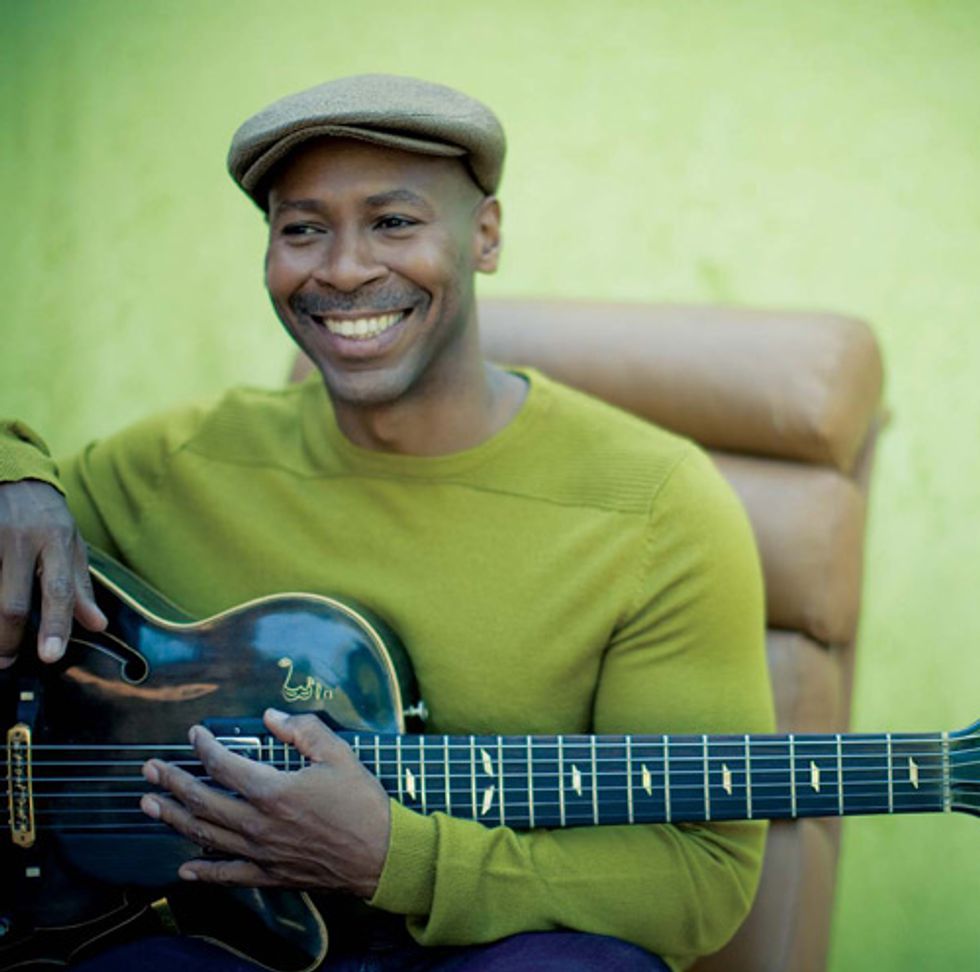
Kevin Eubanks with one of his Abe Rivera-built guitars. “He is very selective in his wood,” Eubanks
says of Rivera. “And he likes to build a nice, fat neck, which is what I like.” Photo by Raj Naik
For 18 years, as bandleader on The Tonight Show with Jay Leno, Kevin Eubanks had one of the highest profile guitar gigs around. Every night, millions of people tuned in to see Eubanks, armed with his arsenal of custom Abe Rivera guitars, direct one of the most revered musical institutions on late-night TV. In May 2010, Eubanks left the show to focus on recording and touring—two parts of his career he’d neglected due to his demanding schedule. While still serving as Jay Leno’s musical (and sometime comedic) counterpart, he recorded Zen Food, his debut release on Mack Avenue Records.
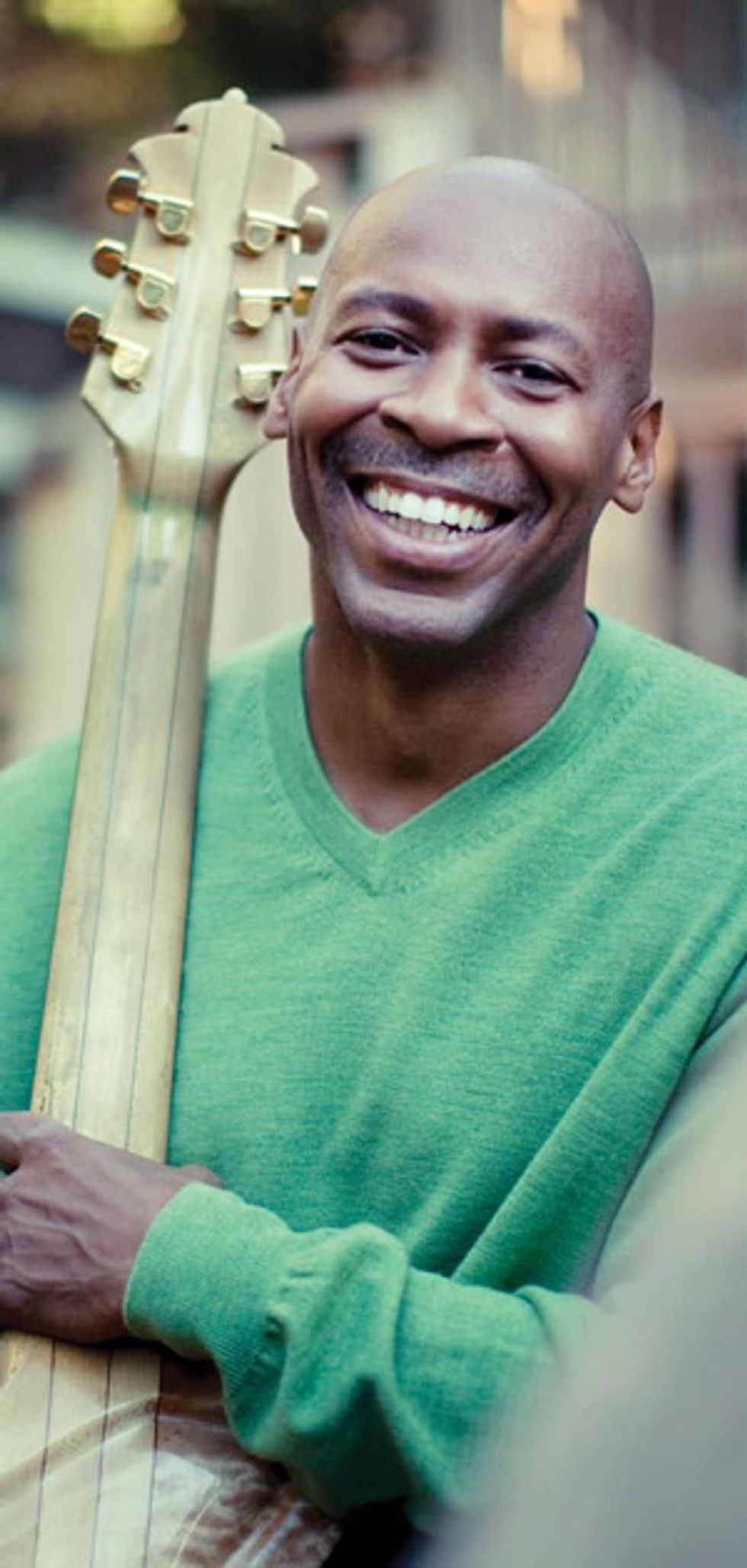 |
Even Eubanks had to adjust to the new rhythm section. “I got lost for a long time because I’ve never played in a Latin group like that. But it all came together.” Rounding out the quintet is keyboardist Gerry Etkins, another musician brought over from The Tonight Show band.
When Eubanks announced his departure, Leno asked him what he’d do first after leaving. Eubanks replied, “I just want to go somewhere where I can finish a song.” Not only does his latest album prove that Eubanks can do more than provide bumper music for commercials, it also shows the depth of his musicianship and influences.
One of the more laid-back tracks on the album is “Adoration.” With its rolling, gentle acoustic intro, it wouldn’t sound out of place on a late-’70s James Taylor album. On the opposite end of the sonic spectrum, the burning feel of “Los Angeles” will make you think you’ve walked into a jam session on the Lower East Side of New York City. Recently, we caught up with Eubanks and talked about life after The Tonight Show, his preference for acoustic guitar, and how Terry Kath rocked his world.
Where did you record Zen Food?
I recorded it at Spirit Studios, a facility I built a few years ago. This is the first real project we’ve put out, so this is like our first run, though we’ve been recording stuff here for a while. The only thing is, I don’t like saying it’s my studio. People always think it’s subpar because it’s not Capitol or one of the others. It took over a year to build this place. We have a nice Neve console, and I like to think we did a good job.
Did you record this when you were still on The Tonight Show?
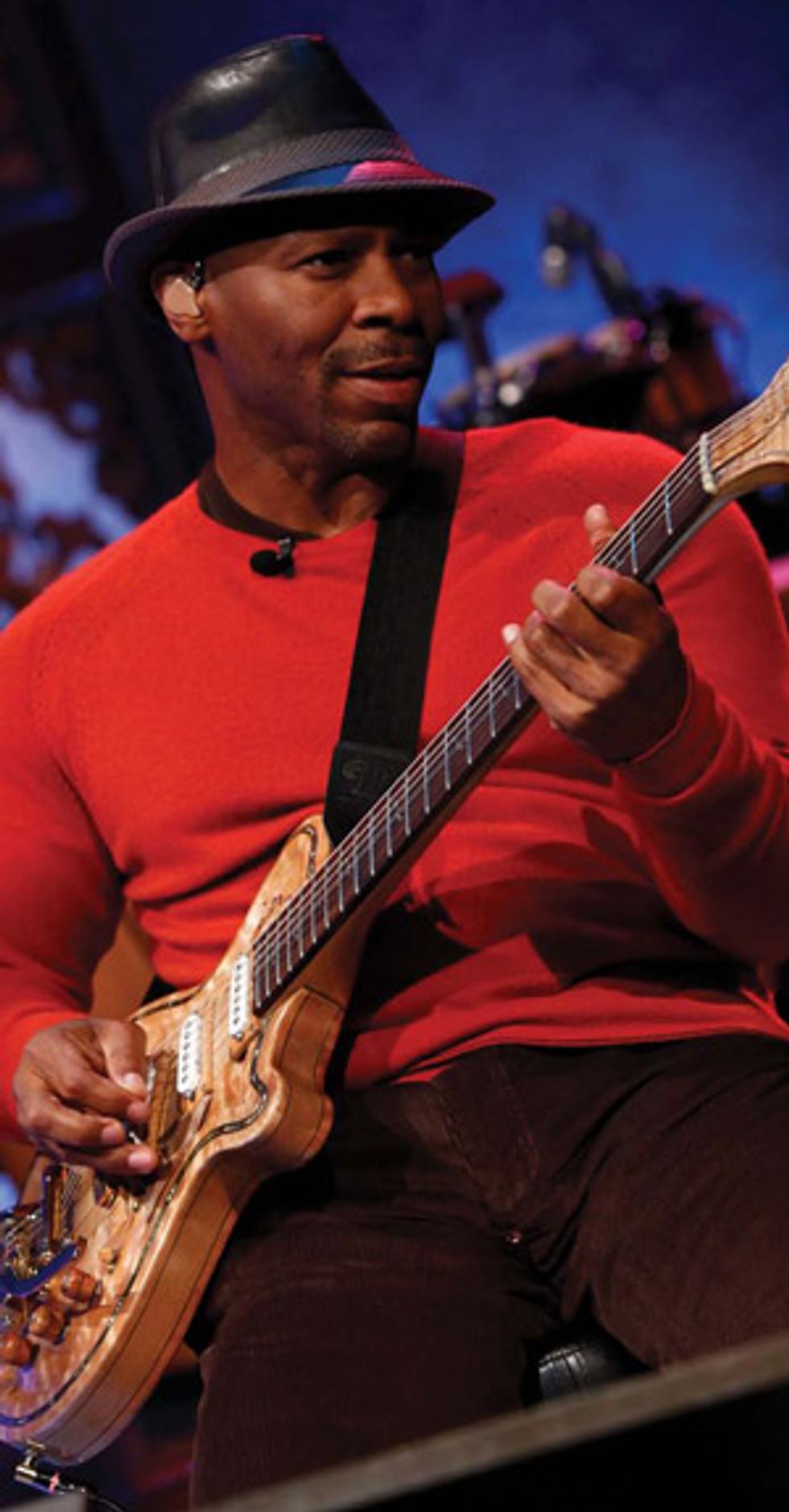 |
Did you record it yourself, or did you bring in an engineer?
I brought in an engineer. Robert Byles recorded this album, but I like to be very much a part of the mixing session. We mixed the record together. My ears are really good, but I don’t have the technical expertise for the recording part. In the mixing, I’m really good at feeling where the energy in the mix comes together.
What is it about Abe Rivera’s guitars that you like so much?
The tone. He is very selective in his wood and he likes to build a nice, fat neck, which is what I like. His overall approach is about the sound of the guitar before you plug it in. Actually, my favorite instrument is the acoustic guitar, just because it feels so personal and warm and everything matters. It comes out of your hands and your body before you plug it in. He wants the guitar, whether it’s a solidbody or hollowbody, to have a certain tone before you plug it in.
Speaking of the acoustic tone of Rivera’s guitars, did you mic the guitar and mix it with your amp signal?
Yeah, on some of the tracks I did. Wow, you heard that?
Yeah! What amps did you use?
I don’t use any particular amplifier. I just use a preamp that was designed by Bruce Seifried from Éclair Engineering. The preamp is called a DMS-1. It took eight months to design. He didn’t want to do it, but we kept going back and forth until we finally got it together.
It doesn’t sound like you use many effects.
That isn’t my thing. I use an Ernie Ball volume pedal and a Klon Centaur. It was so long ago I can’t even remember the name of the guy who makes them. I just bought a bunch of them so I would have them. The distortion is really warm and you don’t lose the identity of the instrument. It really comes off as your sound. This is great for when you are using a hollowbody guitar and you want to crank a little distortion, but you don’t want it too crunchy and you want to retain some presence. You can play a chord and still hear the individual notes in the chord. It’s really a mysterious pedal, man. When you open the back up, there’s all this black stuff over everything, so you can’t see what it’s made of. It’s made by one of those cats.
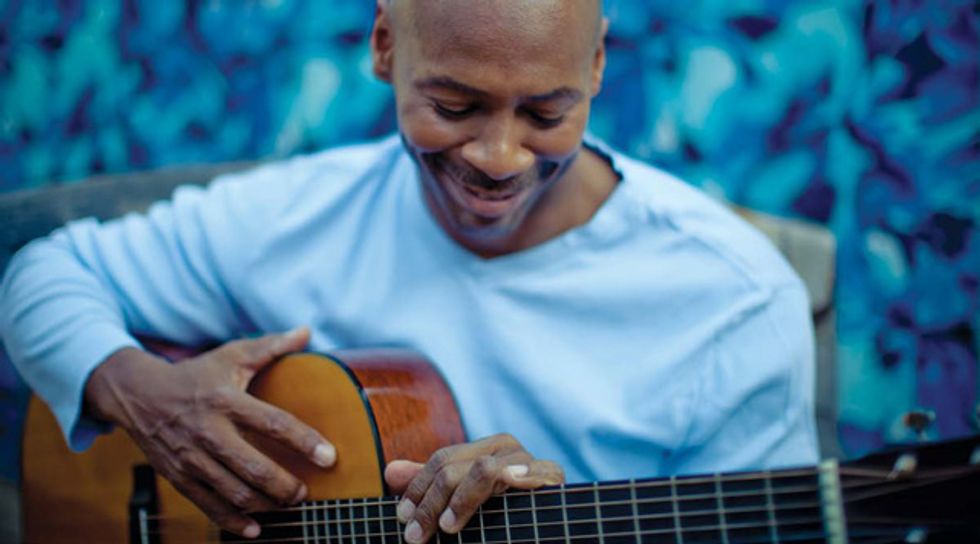
Eubanks. “I thought, ‘Wow, I guess it’s not that big of a deal.’” Photo by Raj Naik
Tell me about the acoustic guitar on Zen Food.
I have an acoustic guitar Dick Boak over at Martin made for me [see sidebar at end]. That’s the one on the record, and I use it for live gigs too. It is just beautiful. It’s a custom guitar with a really wide neck. It probably more resembles a classical guitar than a steel-string acoustic.
You’re known for your fingerstyle technique. Did you always use your fingers or did you start with a flatpick?
Yeah, I went through a phase. I used a pick for about the first seven years I played. Little by little, I started using my fingers along with the pick, like a lot of country players do. I then just dropped the pick and started to use my thumb instead. It was a real natural process.
Was that because of Wes Montgomery’s influence?
It was happening anyway and I wasn’t even really aware that Wes used his thumb. Because I was mostly a funk and rock player, I didn’t come into knowing about Wes Montgomery until I had been playing guitar for a long time. I didn’t know about the whole history of Wes and jazz music at all. I remember the day I discovered that Wes played without a pick. I thought, “Wow, I guess it’s not that big of a deal.” But it wasn’t like I listened to Wes and then decided to use my thumb. That’s why I always felt weird about being labeled a jazz guitar player—I just didn’t come up that way. My main influence for probably the first five years I played guitar was Terry Kath from Chicago. Not until I was thinking about going to college did I start to really get into jazz. My brother, being a horn player, was getting more and more into jazz, so I thought it would be a good way to study music in college.
One of the bluesier tunes on the record is “The Dirty Monk.” The rootsy vibe goes great with some of the composed sections. Was that a conscious decision when you wrote the tune, or did it evolve into that?
I’m open to having the composition change as long as it keeps the personality. We play it and it gets interpreted and when everyone digests it, it comes out a little bit different. It turned into this bluesy kind of thing. I look at the compositions as a starting point and they get changed slightly here and there over time. But that’s all part of composition for me, watching all these changes happen and seeing more of the personality of the song come out. It gets better as we play because we have lived it and played it on a couple tours, or even just a few gigs. Once you play it enough, it’s like “Oh, there’s ‘The Dirty Monk,’ right there.” It’s hard to get the first time.
Has composing been a big part of your musical development?
Always. Composition has been a natural thing since I started to play music. I never really thought about it. It was fun to practice how to solo and fun to write music, so it all just seemed like the same thing. I never differentiated between writing and playing the guitar or being a musician. It’s another presence of music.
Were most of the songs on the album first takes?
We get them pretty early because we had been playing them at gigs for a while. It wasn’t like first takes in terms of the interpretation of the song, more so about the performances. This album wasn’t written for a record company—it’s just a picture of us being on the road during my tenure at The Tonight Show. Before we moved on to the next group of compositions, we wanted to record them because we’re musicians and that is what we do. So it was “in the can,” so to speak, and when I met up with Mack Avenue Records and told them about the album, they loved it.
It’s almost like you approach it backwards.
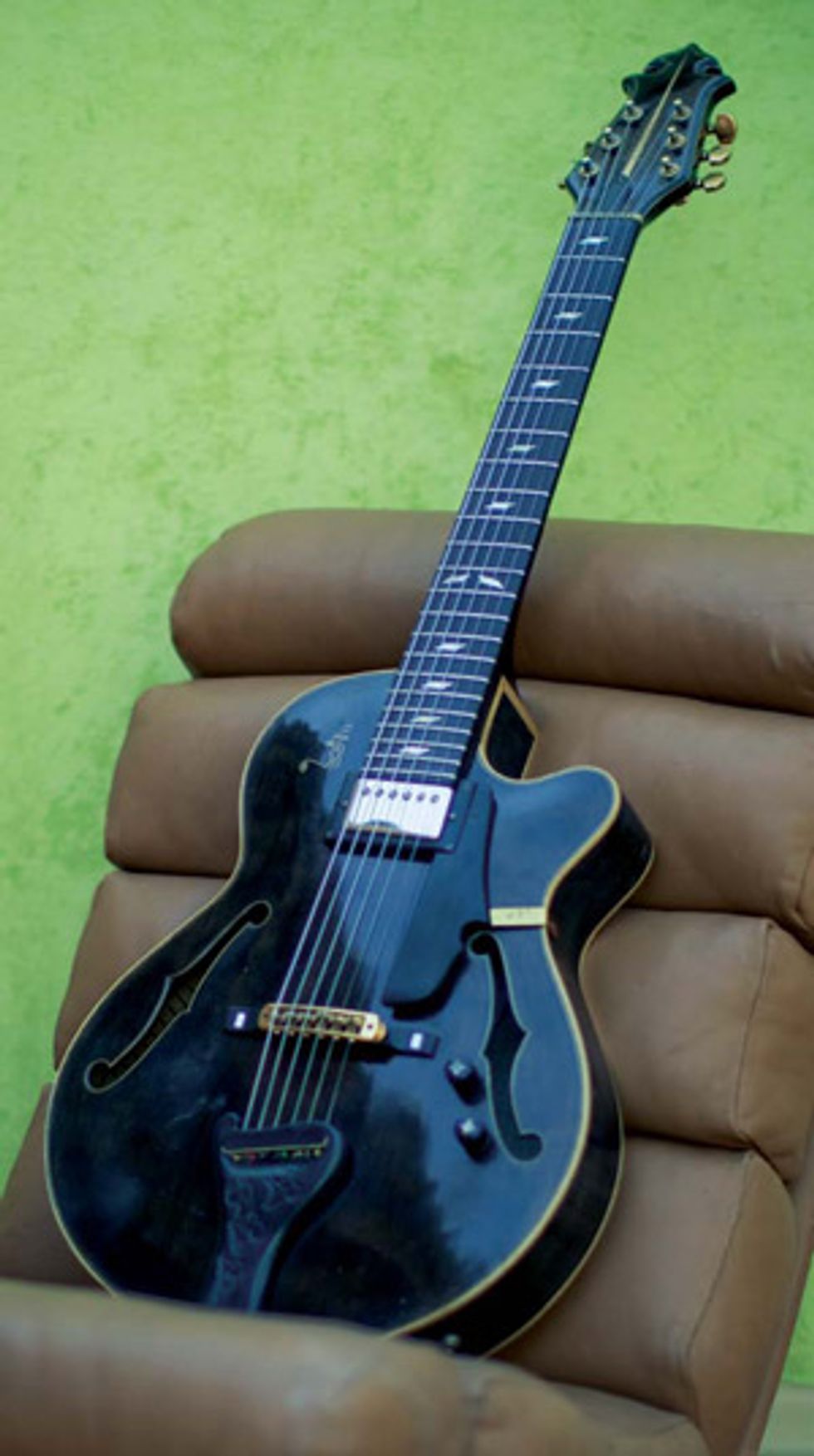 |
You cover a lot of musical ground on this record. It seems the only thing you have in common with more traditional jazz guitar records is that there aren’t any vocals.
Wait until the next record. You won’t be saying that.
Will you be singing?
We are going to have vocals on the next record. I’m already putting it together. I am just about getting into some music since I have seen so much from being in Hollywood, and before that, from being on tour for 15 years. I’m really open and feel confident that, from a musical perspective, it will be really good. Right now, I’m looking for some musical opportunities and adventures and bringing it all to bear with who I am.
Now that Zen Food is out, do you have plans to tour?
Yeah, I want to get out on the road, back on the circuit, and play some gigs. I also want to listen to other musicians, because I really love that when I’m out on tour. I’m looking for an artist in a different genre, someone maybe in bluegrass or progressive country who is in the same boat as me. They need to have a career behind them and want to do something adventurous. You know, do something together where I can bring my audience to their audience and bring their audience to mine and hopefully create a nice record. It’s hard to go out and look for that. Instead, I think it just needs to happen. I am sure there’s an artist out there feeling the same way in their music as I am. I don’t like this whole exclusivity thing that seems to permeate different genres of music. I want to be inclusive—the whole country needs to be more inclusive. Maybe it’s better if everyone contributes to the whole instead of just a few people.
“Das It” is a pretty ferocious duo with you and Smitty.
Yeah, that’s a thing we started to hit on soundchecks. Here and there we’d add pieces to it and finally, we had a forum for it. It developed into a thing and we decided to stick it on the end of the album. It’s pretty intense and I have a feeling it will turn into a full composition. I don’t think we are done with that yet.
Martin’s Dick Boak on Eubanks’ Custom D-18V
When Kevin Eubanks wanted an acoustic guitar, he called up Dick Boak at Martin to create this unique axe. Eubanks was looking for a few key features, namely a wide fingerboard and a big neck. “Kevin wanted a D-18 with a very wide neck,” says Boak. “Much wider—more than 2"—than anything we make normally. It was quite a challenge. I assumed it was because he has large hands, but it turns out he doesn’t have large hands.”
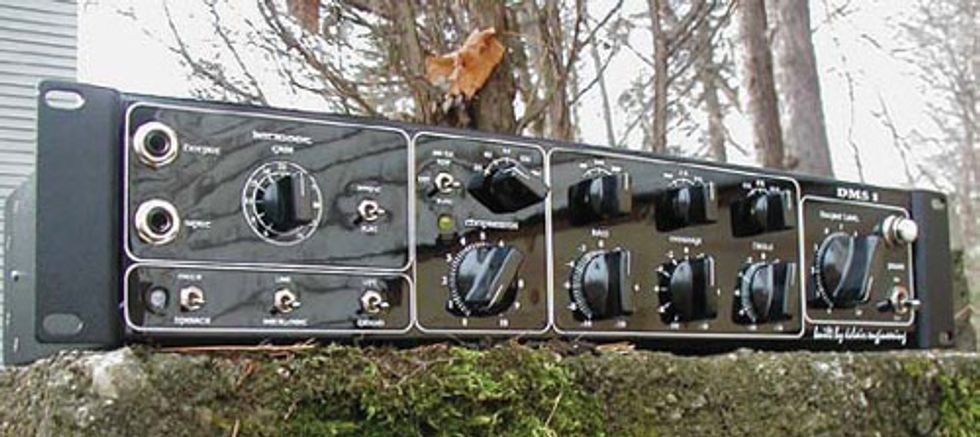
Eubanks isn’t particular about what amp he plays through, but he always plugs into this
Éclair Engineering DMS-1 preamp. Photo by Bruce Seifried
Boak ended up using a classical fingerboard and an untrimmed 12-string neck blank that he found on a shelf in Martin’s wood-acclimating room. According to Boak, the blank was quite old, from the days before modern machinery, in fact. “It had a very long headstock— enough to make a 14- or 16-string guitar. It was very wide too, from the days when necks were hogged out with drawknives.”
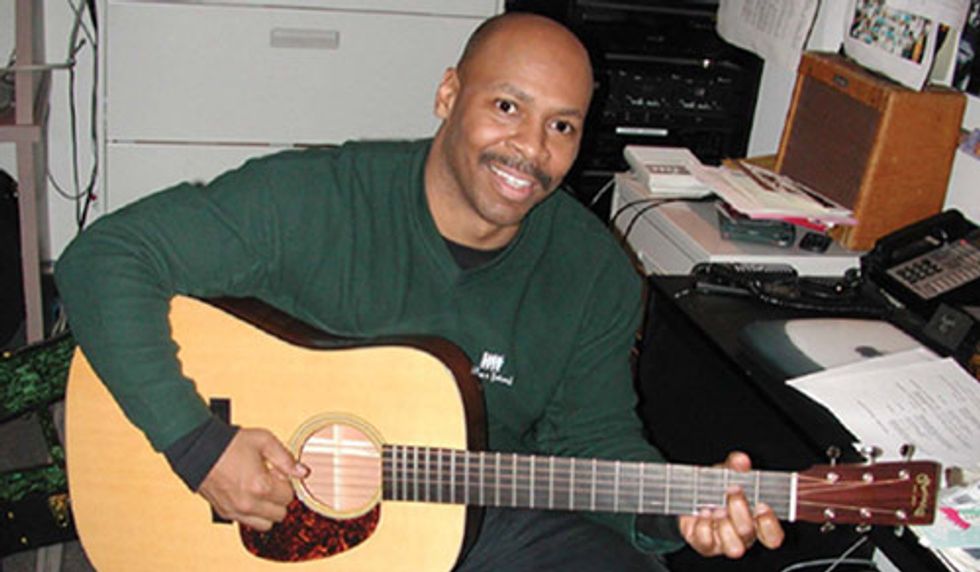
Kevin Eubanks at Martin headquarters with his custom D-18V built by Dick Boak. Photo by Dick Boak
After the guitar was put together, Boak heard exactly what Eubanks had been going for. “The really interesting thing is that the guitar sounded magnificent! All I could figure is that the extra neck wood lent more resonance somehow. All of the guitars he’s ordered with wide necks sound better than their narrow-necked counterparts.”
Kevin Eubanks’ Gearbox
Guitars
Custom Abe Rivera electric, custom Martin flattop
Amps
Éclair Engineering DMS-1 preamp built by Bruce Siefried
Effects
Ernie Ball volume pedal, Klon Centaur
Strings
D’Addario .014-.056
